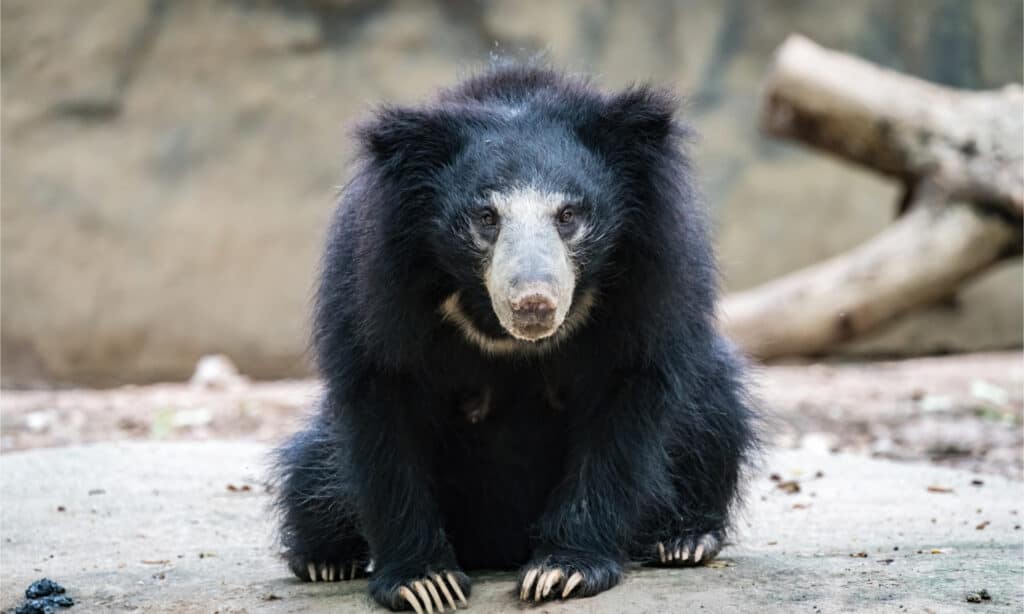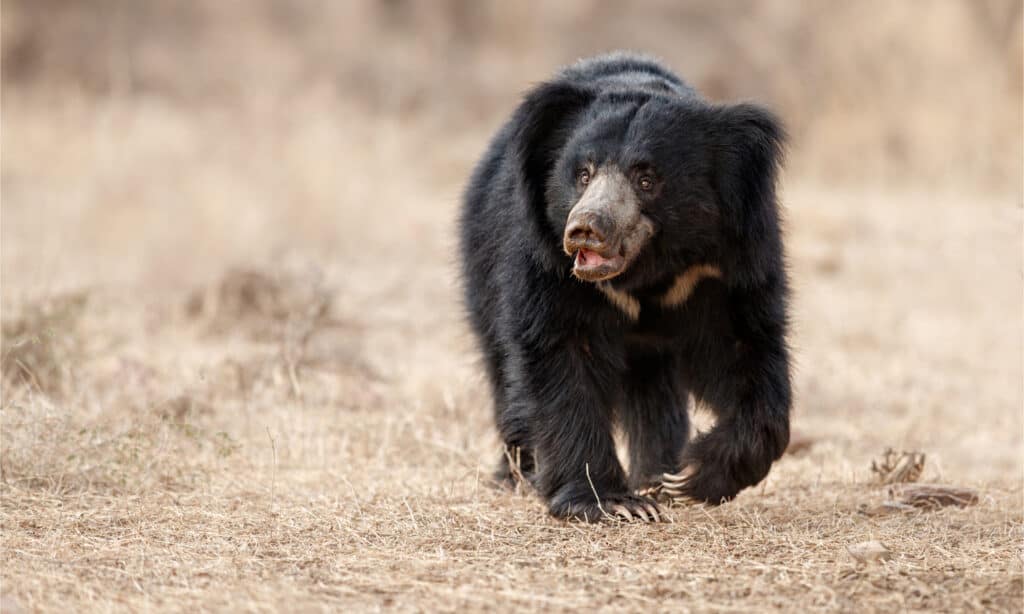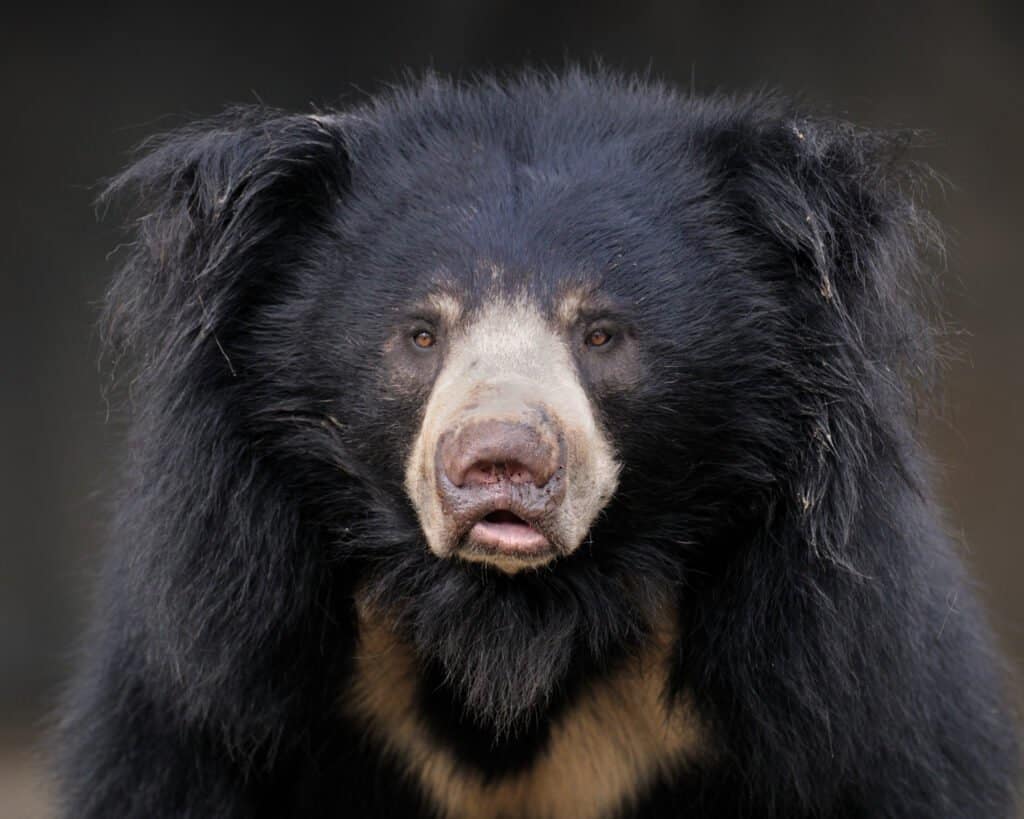Bears have a bad reputation for being bloodthirsty and vicious animals. Whenever you hear of them in the news, it’s probably because of an attack. However, bear attacks are rare – on average, black bears of North America kill less than one person per year. Again, bears try to avoid humans and typically attack only in defense of a perceived threat.
There are many reasons to make bears your favorite animals— especially sloth bears. Although pretty aggressive towards humans, sloth bears are among the most adorable with their attractive round ears and cute faces. Did you know that the British military once kept these bears as pets and trained them to be dancing bears?
One of the most distinctive features of the sloth bear is its gigantic claws, especially when compared to its slim body. There must be a reason for that, don’t you think? We’ll find out in this article.
What’s the Size of a Sloth Bear’s Claws?

A sloth bear’s claws is typically 3 inches long.
©CJansuebsri/Shutterstock.com
Sloth bears (Melursus ursinus) have strong, thick, curved, and long claws of 3 inches. Their claws have the shape of a sickle. Sloth bears get their name from how well their claws look like those of the sloths of South America.
With 3-inch long claws, the sloth bears aren’t the bears with the longest ones. The grizzly bear’s claws can grow as long as 4 inches—just like the sun bear. That of the polar bear is about 3.75 inches long. The black bear seems to have one of the smallest ones, with claws typically shorter than 2 inches.
However, sloth bear claws are a big deal because they’re disproportionately much bigger than their body size. Sloth bears are small species weighing 120lbs-300lbs. They’re about 2 to 3 feet tall with shoulder-length of about 3.5ft- 6.2ft. The Indian sloth bear is bigger than the Sri Lanka sloth bear.
Sloth bears are thinner than black bears (Asian and brown species); however, they have much longer claws than a black bears.
Why are Sloth Bears’ Claws So Large?

With the help of their large claws, sloth bears fight predators and defend themselves against threats.
©PhotocechCZ/Shutterstock.com
Sloth bears’ claws are large to enable them to efficiently dig the earth and termite mounds to maintain a largely insectivorous diet.
They are also useful for putting up a very good fight against rather fearsome predators and both of these purposes are examined in greater detail in the following paragraphs.
Feeding
Sloth bears are insectivorous animals that love to feed on ants, termites, and beetle larvae. Although they may eat fruits like mangoes and wood apples, these insects are their primary food. Their long claws help them dig into the ground to find ants and termites in their nests. They can eat up thousands of ants and termites at once.
Termite mounds and ant nests can be pretty tough to penetrate. However, the sloth bear’s claws are strong for precisely that reason. They use their claws to create a hole that lets them penetrate the mounds. After picking the insects, they uncover them by blowing away surplus dirt and debris with their snouts and lips.
Sloth bears have no upper incisors. This creates a gap in their jaw that allows them to suck the insects up. They do this rather loudly, with their sucking noises still audible from as far as 330 feet away.
These bears can also use their claws to climb trees, searching for honeycombs. That’s why sloth bears are also called honey bears.
To Fight Predators and Defend Themselves Against Threats
Apart from eating ants and termites, a sloth bear’s claws help to protect them from predators and enemies. Tigers are sloth bears’ primary and most dreaded predators. Others include wild dogs, wolves, jackals, leopards, etc. The Indian sloth bear is more dangerous than a grizzly bear, attacking Indians as they encroach on their territories.
When a sloth bear notices a threat, it first stands on both hind legs to reveal the claws on its forepaws. They come very aggressive and can cause severe damage to victims with long, strong claws. Sloth bears love to focus on their enemies’ heads in a fight or attack.
However, despite a sloth bear’s long claws, a tiger will typically win in a fight due to numerous advantages. First, the tiger is bigger than the sloth bear and has more extended claws. Tigers also have excellent combat skills and are faster. Again, the sloth bear has poor vision and hearing.
Considering the tiger’s numerous advantages over the sloth bear, these bears put up a good fight. Their claws can inflict severe wounds on the tiger’s body. Apart from claws, sloth bears also have large canines that offer them a powerful defense against preying animals.
Facts about Sloth Bears

Sloth bears are nocturnal and solitary creatures.
©Nagel Photography/Shutterstock.com
Do you want to know more about sloth bears? These ten fun facts will excite you:
- Sloth bears are native to India, Sri Lanka, Nepal, Bangladesh, and Bhutan.
- If you see a bear transporting its cub on its back, it is likely a sloth bear. They’re the only species that regularly do this. Sloth bears typically carry their cubs on their backs for up to nine months after birth to protect them from predators.
- Sloth bears are nocturnal, with their most active times around dawn, dusk, and the night’s darkest hours.
- They have nostrils that can close completely. This protects them from the dust, dirt, and debris following hunted insects.
- Due to their diet, sloth bears have smaller molars and premolars than other bear species.
- They are vulnerable species as they continue to decrease due to loss of habitation and hunting.
- Sloth bears are solitary animals.
- Qalandars trained sloth bears to do tricks in the past, and there are about a thousand dancing sloth bears in India.
- It’s easy to think that sloth bears are lazy and slow because of their name. However, they can run pretty fast and even outrun a human.
- Sloth bears have a gestation period of 210 days and give birth to blind cubs. These cubs only start walking and open their eyes about four weeks after birth.
The photo featured at the top of this post is © PhotocechCZ/Shutterstock.com
Thank you for reading! Have some feedback for us? Contact the AZ Animals editorial team.







